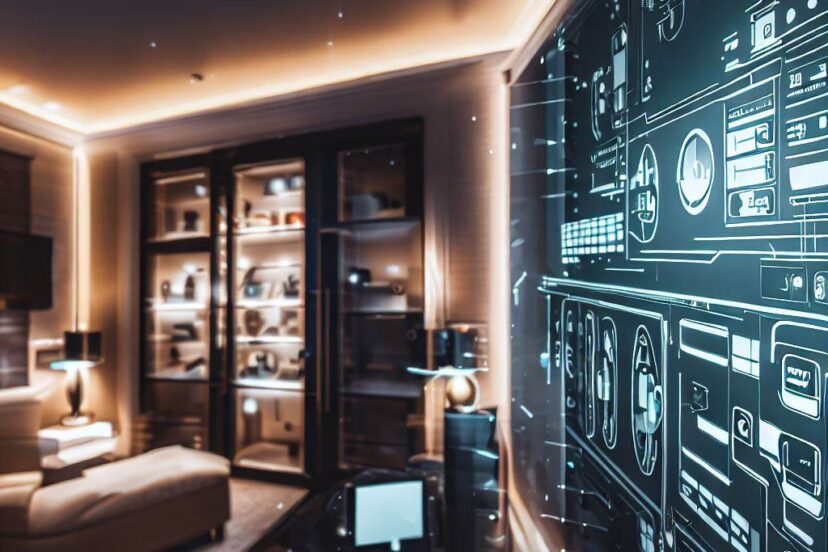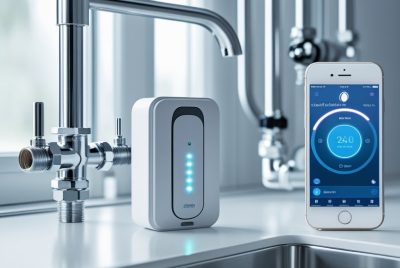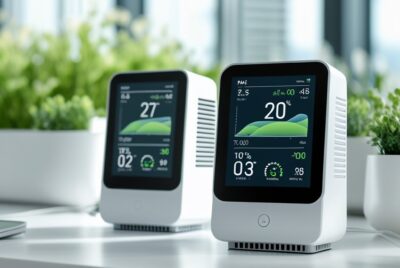Best Home Automation Systems: Making Life Smarter
*We may earn a commission for purchases made using our links. Please see our disclosure to learn more.
Best Home Automation Systems: Your Guide to Choosing the Right Technology
Home automation systems have dramatically transformed the way I interact with my living space. Smart home technology has evolved from a niche market to become an integral part of the modern household. These systems allow me to control various aspects of my home environment through smart devices – all integrated into a cohesive, user-friendly network. The convenience of adjusting lighting, temperature, security, and even appliances with a simple command or a tap on a smartphone brings both efficiency and a sense of futuristic living into today’s homes.

By assessing the plethora of options available, I’ve observed that usability is a key factor in the selection of a home automation system. The systems that stand out are those that offer seamless integration with a wide range of smart devices, as well as those that maintain robust security protocols to protect against unauthorized access. With options ranging from voice-controlled assistants to central hubs that can manage every connected device, the choices are extensive, but the end goal remains the same: enhancing the comfort and functionality of my living space.
The automation capabilities extend not just to convenience but also to energy efficiency, allowing me to better manage resources and reduce wastage. By incorporating smart thermostats and intelligent lighting solutions, I’ve found that it’s possible to create a living environment that not only responds to my needs but also adapts to my lifestyle preferences, all the while being mindful of energy consumption. As home automation systems continue to advance, I remain keen on discovering how these technologies will further refine the essence of smart living.
Understanding Smart Home Basics

In exploring smart home basics, I focus on the essence of home automation, the critical components that make up smart homes, and the network protocols that ensure these pieces work together seamlessly.
Defining Home Automation
Home automation refers to a network of devices, systems, and appliances connected through the internet, enabling control over functions such as temperature, lighting, security, and entertainment, often remotely. I see home automation as the technological evolution to manage household systems efficiently, enhancing comfort and convenience.
Core Elements of Smart Homes
Devices and Interfaces:
- Voice Assistants: Amazon Alexa, Google Assistant, and Apple’s Siri are pivotal for voice control.
- Smart Devices: Ranging from lights, locks, thermostats to cameras and sensors.
Control Layer:
- Smart Hubs and Apps: Serve as the central interface for managing devices.
- Automations: Customizable rules and scenes, making devices interact based on events.
Application:
- Smart devices work collaboratively for security, energy efficiency, and convenience.
Network Protocols and Compatibility
Protocols:
- Wi-Fi: Ubiquitous for connecting devices to the internet.
- Zigbee & Z-Wave: Low-power mesh networks for device-to-device communication.
- Bluetooth: Often used for proximity-based device control.
- Matter (formerly Project CHIP): Aims for increased interoperability across brands.
Considerations:
- Compatibility: Devices should share a common protocol for seamless integration.
- Range and Reliability: Protocols like Zigbee and Z-Wave offer extended range with less interference.
By understanding these facets of smart home technology, including the role of platforms like Amazon Alexa, Google Assistant, and Siri for voice control, I’ve ensured that all elements are not only interoperable through standards like Matter but also secured in a network robust enough for daily use. Integrating these systems requires careful consideration of the network protocols to ensure fluid communication between my smart devices.
Setting up Your Home Automation System

When I set up a home automation system, I focus on the underlying ecosystem, thorough installation, and seamless integration with various smart devices.
Choosing the Right Ecosystem
I begin by considering the ecosystem that best aligns with my preferences and existing devices. Apple HomeKit is renowned for its data privacy and robust security, ideal if I’m invested in the Apple environment. For a more open approach, Home Assistant offers compatibility with a broad range of smart devices and isn’t confined to a single brand. I ensure that the ecosystem I choose supports the devices and services I need, from voice controls to app management.
Installation Process
For the installation, I generally follow a step-by-step approach outlined by the manufacturer’s guidelines. The hardware setup includes placing sensors in key areas, installing smart locks on doors, and setting up smart plugs and smart lights. I leverage tutorials and customer support when necessary to avoid installation mishaps.
Table: Basic Installation Steps
| Step | Description |
|---|---|
| 1. | Positioning hardware like sensors and smart locks |
| 2. | Connecting devices to power and ensuring they are turned on |
| 3. | Installing any necessary bridges or hubs for connectivity |
Integration with Smart Devices
Once the hardware is in place, I use the mobile app corresponding to my chosen ecosystem to connect each device. The app serves as a central hub for controlling all aspects of the system from my phone or tablet. I pay close attention to ensure that devices like IKEA’s smart lighting integrate seamlessly, providing me easy control over the illumination of my space. With voice controls through platforms like Amazon Echo or Google Home, I can manage my devices hands-free, an extremely convenient feature especially for accessibility. Integration is verified through rigorous testing, ensuring all components communicate effectively and respond to commands as expected.
Key Home Automation Devices

In my experience with home automation, certain devices stand out as foundational for a smart home. They serve as the building blocks for a highly interconnected and efficient living space.
Voice-Activated Assistants
Voice-activated assistants like Amazon Echo and Google Home serve as the nerve center for smart homes. I’ve found that using Alexa or Google Assistant allows for seamless control over various devices with simple voice commands.
Security and Monitoring
The security aspect is critical, and devices like security cameras and video doorbells have become indispensable. For example, Apple’s HomeKit integrates well with a variety of cameras for a secure and private surveillance network.
Climate Control
For climate control, smart thermostats like Ecobee or Nest leverage energy efficiency. They adapt to my habits and can be adjusted remotely, leading to potential savings on energy bills.
Lighting and Energy
Smart light bulbs and energy monitoring tools provide convenient and efficient ways to manage lighting and track energy usage. I’ve employed smart light bulbs that adjust intensity and color, as well as integrate with systems like Amazon Echo for voice activation.
Advanced Features and Customization

In the realm of home automation systems, advanced features and customization have become pivotal. I’ll explore how these systems can automate daily routines, interface with a slew of third-party devices, and provide remote access and control to shape a smart home environment that’s uniquely responsive to personal habits and preferences.
Automating Daily Routines
I find that the true genius of a home automation system lies in its ability to craft seamless daily routines. The best systems allow users to create “scenes” or routines which are automated events that are triggered by specific conditions such as time of day, voice commands, or other sensor activity. For instance, I can tell my smart display, “Good morning,” and trigger a routine where my curtains open, the coffee maker starts, and my favorite news channel plays on the smart display.
- Morning Routine Example:
- 7:00 AM: Smart blinds open automatically.
- 7:05 AM: Robot vacuum begins cleaning.
- 7:15 AM: Smart air purifier adjusts to daytime settings.
Personalization and Third-Party Integrations
My system’s ability to personalize experiences is enriched through third-party integrations, often enabled by intelligent platforms like IFTTT (If This Then That). Utilizing this, I can orchestrate complex interactions between a range of devices. For instance, a GPS trigger might inform my smart thermostat to adjust the temperature when it senses I’m heading home. It extends the ecosystem beyond the proprietary gadgets to include a plethora of smart home gadgets, ensuring that my personal preferences are met with pinpoint accuracy.
- Examples of Third-Party Product Integrations:
- Smart Lights: Control settings based on time of day or via voice commands.
- Security Cameras: Receive alerts based on motion detection.
- Smart Locks: Auto-lock or unlock when you are nearing your front door.
Remote Access and Control
The ability to manage my home remotely is indispensable. Through a smart hub or a dedicated app on my smartphone, I can monitor and control smart devices from anywhere. Whether I need to check if the lights are off or adjust the smart air purifier settings, the power rests at my fingertips. Remote access isn’t just about convenience; it’s also about peace of mind, knowing that I can always oversee and adjust my home environment, no matter where I am.
- Key Smart Home Remote Control Functions:
- Check and modify the status of all connected devices.
- Receive real-time notifications and alerts.
- Access live security camera feeds.
By prioritizing these advanced features and customization options, my home automation system not only responds to my needs but also proactively anticipates them, crafting a living space that feels like an extension of my own preferences and lifestyle.
Best Home Automation Systems: Optimizing for Comfort and Efficiency

When it comes to home automation systems, I focus on integrating technology that harmonizes comfort and efficiency. This is paramount, as convenience and energy savings go hand in hand, often influenced by advancements in security and privacy.
Achieving the Desired Convenience
My approach prioritizes user-friendly interfaces and seamless integration. For instance, Samsung SmartThings enables control over a wide array of devices, including smart TVs, through a single platform. By creating routines, I can easily automate tasks like turning lights on/off and adjusting temperatures, matching my daily schedule to optimize convenience.
Maximizing Energy Savings with the Best Home Automation Systems
I apply smart home strategies that lead to significant energy savings. Thermostats, such as those compatible with Savant or Control4 systems, can be automated to learn my preferences, adjusting the climate control based not just on time of day but also on external weather patterns. These subtle adjustments contribute to lower energy consumption without sacrificing comfort.
Enhancing Security and Privacy
Security systems, including Vivint Smart Home, provide a robust array of features like video doorbells and security cameras, all while emphasizing privacy. Smart cameras can be set to record or notify me only when there is unusual activity. Furthermore, with airtight encryption protocols, the platforms ensure that my data and home privacy are never compromised.
Choosing a Home Automation System
When selecting a home automation system, I prioritize value, ecosystem compatibility, and the quality of support. These aspects are critical for ensuring that your investment is sound and that the system meets your home security and automation needs effectively.
Evaluating Cost and Value
Pricing: Home automation systems range from economical DIY options to high-end systems with more features. Subscription services, often billed monthly, may be required for full functionality. You can expect basic plans to start around $20 per month.
Contracts: Some systems may require long-term contracts, while others offer flexibility with month-to-month agreements. It’s important to understand the commitment level before purchasing.
Device Compatibility: Ensure that the automation system supports a variety of smart home devices. This is crucial for future-proofing your home setup and maximizing the value from the system.
Assessing Product Ecosystems
Compatibility: I look for a system that is compatible with a wide range of products. This would include support for major voice assistants like Amazon Echo or Google Home and integration with other smart home systems.
Smart Home Systems: The best ecosystems allow you to control lighting, thermostats, security cameras, and other smart devices from one central platform. I consider this a key value proposition for a seamless and integrated home experience.
Considering Installation and Support
Professional Installation: Some systems require professional installation, while others are user-friendly and designed for self-installation. This choice affects the initial setup experience and sometimes the overall cost.
Customer Service: High-quality customer service is vital, especially when encountering issues with technical setups or troubleshooting. I look for providers that are highly ranked by credible sources for their support services.
By carefully evaluating these factors, I can choose a home automation system that not only meets my current needs but will also serve me well into the future.
Frequently Asked Questions
In this section, I’ll address some common inquiries about home automation systems, focusing on features, security, types of systems, device compatibility, trends, and user reviews. My goal is to clarify these key areas to help you make informed decisions.
1. What features should I consider when choosing a home automation system?
When selecting a home automation system, I consider the system’s compatibility with various devices, ease of use, integration capabilities, automation features, and whether it supports voice control. For example, systems like Amazon Echo Plus are highly rated for their broad compatibility and user-friendliness.
2. How do security and privacy compare among top home automation systems?
Security and privacy are paramount in home automation. I look for systems that offer strong encryption and regular software updates to protect user data. Apple HomeKit is known for its data privacy and security, while others like Ring Alarm offer robust security systems designed to protect your home.
3. What are the benefits of professional vs DIY home automation systems?
Professional systems usually offer comprehensive service, including installation and ongoing support, ideal for those who prefer a hassle-free experience. DIY systems like Home Assistant, on the other hand, might require more setup but can be highly customizable and often less expensive.
4. How do different home automation systems integrate with existing smart home devices?
Integration is crucial for a seamless smart home experience. Systems like Google Nest are popular due to their user-friendly interface and seamless integration with other Google products, but I always check for compatibility with my existing devices before choosing a system.
5. How do user reviews rate the reliability and user-friendliness of the leading home automation hubs?
User reviews often highlight reliability and ease of use. Systems like the Kasa Smart WiFi Plug by TP-Link receive positive feedback for their affordability and straightforward control, while user-friendly interfaces are frequently praised in reviews of Google Nest products.




